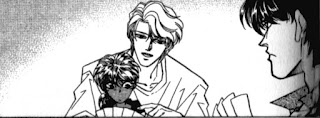 In the prior post, I discuss the power of archetypes. I end by admitting that stereotypes--as opposed to archetypes--often fall flat. I've read romance novels and manga where the characters were little more than their labels--dominating hero, sweet heroine; seme, uke . . .
In the prior post, I discuss the power of archetypes. I end by admitting that stereotypes--as opposed to archetypes--often fall flat. I've read romance novels and manga where the characters were little more than their labels--dominating hero, sweet heroine; seme, uke . . .So what is the difference between an archetype and a stereotype, literarily speaking?
The archetype, as opposed to the stereotype, is all of a piece.
My positive example couple for this blog is Ryo and Dee from the series Fake (my non-manga back-up example can be found on Votaries). Ryo is the supposedly steadier, quieter member of the duo. He is good at paperwork, actually saves his money, and appears more reasonable/rational in conversation. He is also an excellent sharpshooter.
Dee is the Mike Logan of the two (the series is set in NYC; Ryo and Dee are cops). He is impulsive, romantic, seemingly boastful (but yeah, it's mostly talk), shrewd, and street-smart. He is an excellent detective.
As one might suppose, Ryo comes from a wealthier, more stable background: two loving parents (who are killed, propelling a young man who would typically have gone into business or civil law to go into criminal justice instead--think Jamey from Blue Bloods) and a large extended family.
 |
| True to type, Ryo is also good with kids--though |
| Dee can be perceptive about their behavior |
| when it reminds him of himself. |
Dee, on the other hand, was raised in a Catholic orphanage. Although he never knew his parents, he has a strong filial relationship with the woman who runs the orphanage. He could have gone "either way" as a teen and seems to have chosen the justice side from an innate distaste for the sleaziness of the criminal lifestyle.
Ryo's reasonableness extends to him not believing in ghosts, something more romantic (despite being more shrewd) Dee does: "Yup, that how it always works, isn't it?" Dee complains. "It's always the sensitive guys you'd expect to believe in things like ghosts that are the uber-realists."
Ryo's reasonableness is also of a different brand than Dee's practicality, especially when it comes to holding a grudge. Ryo is the type to mull on something for years; Dee is the type to blow up at someone, then shrug his shoulders and move on.
Ryo's tendency to ruminate makes him apparently more dreamy (though infinitely more skeptical) than Dee. As Dee says to Binky, "He may look flighty but he's actually quite reliable" to which Binky responds, "I think he looks reliable but is not all there." Dee, the supposedly more irresponsible partner, never fails to follow through. Once he's on your side, he's on your side forever.
 The variations within Ryo and Dee's responses give them ballast while keeping them consistent to their archetypes. It is utterly believable that Ryo would keep information about his parents' killers to himself while Dee would dash off to confront a villain. It is also believable that Ryo would feel a little weepy on Christmas (near the time his parents were killed) while Dee would burst into his apartment, carrying presents and a teeny-tiny tree (love that teeny-tiny tree.)
The variations within Ryo and Dee's responses give them ballast while keeping them consistent to their archetypes. It is utterly believable that Ryo would keep information about his parents' killers to himself while Dee would dash off to confront a villain. It is also believable that Ryo would feel a little weepy on Christmas (near the time his parents were killed) while Dee would burst into his apartment, carrying presents and a teeny-tiny tree (love that teeny-tiny tree.)In other words, assigning archetypes doesn't start and end with a single event or adhere only to the characters' personal relationship. It washes through all aspects of their lives and dovetails with prior behavior/events. Stereotypes, on the other hand, tend to remain consistent only so long as a character needs to be DOMINANT or TRUSTING or PUSHY or . . . whatever.
 |
| Goh and Taki of Yellow comprise similar archetypes to |
| Ryo and Dee; yet, they are specific characters |
| with specific backgrounds. |
Stereotypes, on the other hand, never move beyond the annoying assumption that the reader will accept the behavior because, well, that's what a mentor or villain or seme or uke does. The archetype, on the other hand, becomes the character becomes the behavior which confirms the archetype.
And archetypes are powerful! Well-crafted archetypes create interesting characters who capture their fans' hearts. They become more real than any amount of "well-roundedness" could possibly manage.